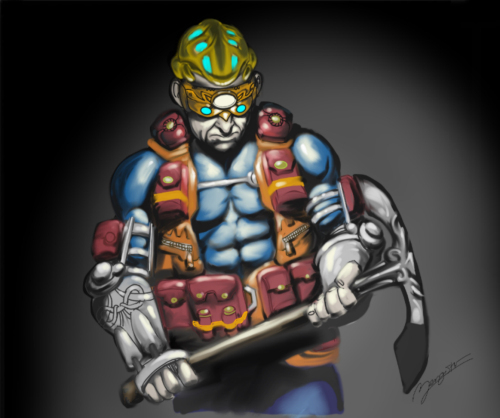M.J. Gallagher's Blog, page 4
May 31, 2015
The Seckry Sequence: A Book Review
City of the Falling Sky is a terrific debut novel for young adults, but requires significant editing before it can become a genuine bestseller.
Let me just say first of all that I think Joseph Evans has great talent as a storyteller. His imagination and world-building skills are something to be admired, and you can’t help but get sucked into this saga. City of the Falling Sky, the first title in The Seckry Sequence trilogy, is a sci-fi coming-of-age tale that hits the ground running.
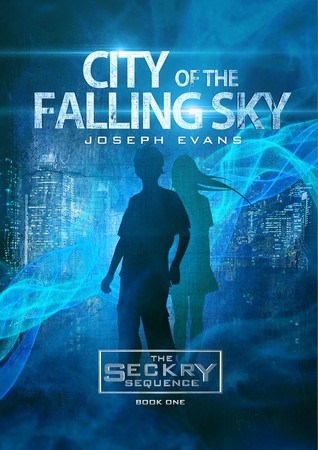 Mainly set in the futuristic dystopian city of Skyfall, Seckry is a teenage boy whose life is turned upside down when he and his family are forced to relocate from their rural home by the monopolistic Endrin Corporation. Attending a new school, he is soon immersed in an intriguing curriculum (literally straight out of science fiction) and making friends with a whole bunch of relatable characters. As expected from this type of young adult adventure, the mysteries surrounding much of his daily life quickly pile up – very reminiscent of J.K. Rowling’s style in the Harry Potter series – which tackle subjects such as the disappearance of Seckry’s father, the secret and unethical projects of Endrin, the motives of a hideous serial killer, and just who stole the classroom pet. The more you read, the deeper and darker the plot becomes. To be fair to the author, he has clearly put a lot of thought into the many story threads and subplots, and it’s good fun as a reader to juggle them all throughout the book.
Mainly set in the futuristic dystopian city of Skyfall, Seckry is a teenage boy whose life is turned upside down when he and his family are forced to relocate from their rural home by the monopolistic Endrin Corporation. Attending a new school, he is soon immersed in an intriguing curriculum (literally straight out of science fiction) and making friends with a whole bunch of relatable characters. As expected from this type of young adult adventure, the mysteries surrounding much of his daily life quickly pile up – very reminiscent of J.K. Rowling’s style in the Harry Potter series – which tackle subjects such as the disappearance of Seckry’s father, the secret and unethical projects of Endrin, the motives of a hideous serial killer, and just who stole the classroom pet. The more you read, the deeper and darker the plot becomes. To be fair to the author, he has clearly put a lot of thought into the many story threads and subplots, and it’s good fun as a reader to juggle them all throughout the book.
Many of the reviews I’ve read about City of the Falling Sky have been critical of Evans’ obvious inspiration by Rowling and Harry Potter. I disagree: I think he should be applauded for taking a structure that obviously works and applying a fresh concept to it. The virtual reality game of Friction has all the ingenuity and revitalising subplot elements that Potter fans adore about Quidditch, not to mention something that most videogame players will drool over. By his own admission, Evans is also a huge fan of the iconic videogame Final Fantasy VII, and anyone familiar with that storyline will see its influence stamped all over this book. The parallels between Endrin and Shinra, Darklight and Hojo, and the Innoya and Cetra are just a few of these. Another thing that the reviews haven’t really picked up on is the religious undertones throughout the novel. I think Evans has been clever in the way that he has reflected Christian beliefs in the lore and origins of Seckraman, but does not do so in an inflammatory manner. Perhaps that’s something that only older readers might spot.
However, as great a tale as this is, it fails to hit top marks on a number of key development factors. The recurring theme that was most obvious to me was that the reader is often given an elaborate scenario or character role, but only a shred of explanation as to how everything came together. It’s almost as if Evans has decided on the “my story, my rules” approach whereby the reader just has to accept it all at face value. An example of this would be how Seckry’s hatred of Endrin is touched on a few times in the early chapters, but not explored too thoroughly, and at no point does he appear to be deliberately mischievous or roguish. Then, out of nowhere, he agrees to break into a highly-restricted facility. Alone. On behalf of an online stranger. Without up-front payment or insurance. Because he’s angry at Endrin. Admittedly, this is one of the major plot holes, but it is by no means isolated. While the subplots are enjoyable, there are a couple that could be cut without actually making any difference. One that springs to mind is the headmaster’s illness and past. In a book that already has so many balls in the air, a thread like this might be considered overkill. One final point is the simplicity of so many things (though, again, this is only from the point of view of an adult writer and not necessarily reflective of the target audience). The twists regarding the Vitruvian Man-style door lock or the old painting with the symbol among others were too easy to spot, and the idea of having the last 20 pages tie just about everything up in a neat little bow was both unrealistic and anti-climactic for me.
City of the Falling Sky is also without a shadow of doubt the work of a first-time author: the writing standard is relatively poor. For the target audience, this is arguably not too problematic as they are less likely to read the book with editor glasses on. Other authors or writers, though, will be cringing a few times each chapter at the typos, terrible grammar and regular inconsistencies in style. As a fantasy author myself, I’m all too aware how difficult it is to catch all the mistakes and how invaluable a proofreader’s opinion can be, but even more important is someone who can make suggestions to improve your product. I think the novel severely lacks this, and it had a really negative impact on my enjoyment levels. I genuinely hope that Evans or another party will return and thoroughly edit this book as to leave it as it is will be hugely detrimental to his future career. It’s also worth noting that he has recently been taken on by a literary agent so I would expect these problems to be fixed sooner rather than later.
Despite the criticism, I would very much recommend City of the Falling Sky to anyone who likes their young adult books to be engaging thrill rides without the hassle of convoluted and challenging plots. Evans has produced a fantastic story with twists and turns that is pretty much guaranteed to leave you entertained – as long as you can deal with regular errors and a few “eh?” moments. I suppose you could describe it as a sci-fi Harry Potter set in Final Fantasy VII’s Midgar. That alone would be enough to sell it to me, but the fact that it is available to download in any digital format for free makes it all the more appealing.
Check it out on Amazon or Smashwords, and follow the project on Facebook and Twitter.
Download the FREE 40-page preview edition of our forthcoming novel Axtelera Ray: The Chronicles of Astrone as a PDF or ePub to find out why it’s being rated at 5 stars!!!
The post The Seckry Sequence: A Book Review appeared first on Axtelera-Ray.
May 27, 2015
The Truth about British Dragons
Few mythical species can claim to be as diverse or globally recognizable as dragons, but how we perceive them nowadays reflects heavily on British dragons.
Draca is the Old English word for dragon, Dracan is plural. The term itself is derived from Dracō in Latin – which in turn was derived from the Ancient Greek Drákōn – with connotations of a malevolent, serpentine nature. It is argued that the origins of the word are found in Indo-European language, and that an early description may have been close to “monster with the evil eye”. An equivalent of Draca in Modern English would be Drake, though the generic “dragon” is far more commonly used. The reason for this is that what much of the western world understands a dragon to be is based on the medieval accounts of Dracan, despite numerous other examples predating them by thousands of years. The earliest written appearance does not actually occur until the Anglo-Saxon epic poem, Beowulf, whose manuscript dates between the 8th and 11th centuries AD.

‘A Female Draca’ by Andy Nicol
While similar to other Germanic dragons such as Lindwurmen andWyverns with scales and horns and reptilian bodies, Dracan are defined as having four legs separate from their bat-like wings, a muscular tail and the ability to breathe fire. Said to dwell in underground lairs and caves, they are generally portrayed as evil and destructive, but also cunning and greedy; many stories involve them hoarding ancient or cursed treasure. An attribute that further lends itself to the association with snakes is that their bite can be venomous, or that their movement is “bendy”.
There are many fascinating aspects regarding the evolution of Dracan in the folklore of what is now the British Isles. The invasion of the Saxons in the 5thcentury brought with it their Germanic beliefs in the existence of wicked dragons, transferring the qualities of their monstrous, water-dwelling Lindwurmen onto native poison-breathing Wyrmas. In the traditions of the indigenous Celts, Ddreigiau were powerful and benevolent creatures with four legs and wings, as old and as natural as the mountains. Y Ddraig Goch – The Red Dragon (now synonymous with Wales) – became a symbol for the Britons in their fight against the Saxons, who in turn were represented by a menacing White Dragon: the foul hybrid of a Ddraig and a Wyrm. By medieval times, they were considered ill omens, and became a symbol of trouble and infertility that could only be appeased by offering maidens as a sacrifice. In the Bible, Satan is described as a dragon, and several tales involved Christian heroes slaying Dracan gained popularity throughout Europe, the most famous of them being that of Saint George.
In Axtelera Ray:
Dracan are enormous and vicious reptilian monsters with four legs and leathery wings that can span several dozen feet. Other than their ability to unleash infernos from their throats, males are easily distinguished by the huge ivory horns on their crown like the antlers of a stag. While most species of dragon are territorial and rarely travel far from their dwelling, Dracan have been known to fly great distances to hunt or to fight. The largest concentration of their nests can be found in the volcanic regions of Múspell, though they also inhabit a number of islands in the Sea of Stoorworm between the Kingdoms of Yggdrasil and Papan’ádh, where fierce battles can often erupt with the native Dreigiau. One of the most notorious Dracan in recent times was Villield – called the ‘Wildfire’ – who killed Kžarine’s parents and burned her hometown to the ground. The scales of their skin are considered to be among the strongest substances in Octavia, and are used in the manufacturing of military dragonleather armor.
 Download the FREE 40-page preview edition of our forthcoming novel Axtelera Ray: The Chronicles of Astrone as a PDF or ePub to find out why it’s being rated at 5 stars!!!
Download the FREE 40-page preview edition of our forthcoming novel Axtelera Ray: The Chronicles of Astrone as a PDF or ePub to find out why it’s being rated at 5 stars!!!
Discover more from our incredible artists at their respective Facebook pages: and Andy Nicol.
Learn about other creatures by visiting our encyclopedia directory or mythical races directory
The post The Truth about British Dragons appeared first on Axtelera-Ray.
May 11, 2015
Osiris
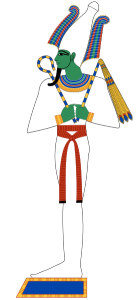
“Standing Osiris” by Jeff Dahl depicting his appearance on the pyramid hieroglyphs.
Throughout global mythology, some weird and wonderful tales have emerged to explain the various elements of our world. One of the oldest and oddest involves the Egyptian Lord of the Underworld: Osiris.
The “Osiris Myth” is one of the earliest and most famous of Ancient Egypt, originating from the Abydos region approximately 4,500 years ago. It details his murder and subsequent resurrection by his wife, living long enough for her to conceive Osiris’ child. He was among the culture’s most widely-venerated deities, believed to be one of the first pharaohs, and credited with introducing civilization to Egypt. Osiris is the “Lord of the Dead”, a kind and merciful judge who grants the righteous deceased access to the eternal paradise of Aaru. It is also his responsibility to manage the flow of life so that seasonal harvests continue their cycle. This is reflected in the green color of his skin: it is symbolic of rebirth.
In Axtelera Ray:
Osiris was a king who lived millennia ago. He was powerful and just, and beloved by his people, but was murdered by his jealous brother, Set. To prevent the king coming back to life, Set dismembered his body and scattered the various parts. However, the fragments were eventually found by Queen Isis, and reassembled using great magic. She and the revived Osiris went on to produce a son and heir. When he died, his ability of resurrection was stored in an Everstar, and remained in his dynasty for eons until it was hidden by his descendants.
Learn more cool history and mythology trivia at our encyclopedia.
The post Osiris appeared first on Axtelera-Ray.
April 26, 2015
Think you know dwarfs? Think again…
Many of us will be familiar with the appearance and nature of dwarfs from fantasy books and movies, but so much of what we know is pretty far removed from their original roles in mythology…
Dvergr is the Old Norse word for dwarf, Dvergar is plural. Like elves, dwarfs originate from Germanic mythology, though the modern perception of them is quite unlike how they were thought of prior to the Christianization of Northern Europe. The Anglo-Saxons used the word dweorg to denote a supernatural being which lived in the ground and may have been associated with smiths or illness. Old Norse mythology provides significantly more information on dwarfs, though much of it is the subject of debate.
The race features heavily throughout folklore and the legendary sagas, and their roles and abilities are varied. For example, some tales say that they are wise and molded men from the earth so that the gods could give them life, or even have them holding the sky aloft, while others call them fiendish murderers and treasure hoarders or liken them to maggots. What most seem to agree on, however, is that dwarfs are master craftsmen of weapons, armor and other fine items. They are often described as bearded and will turn to stone if exposed to sunlight. Their home is Niðavellir (“Dark Dwelling” or “Dark Fields”), one of the Nine Worlds of Norse cosmology, said at times to be a dry and mountainous landscape with sandy plains, and the halls and strongholds of the dwarfs are subterranean.
An interesting factor in this area of mythology is that there is little evidence prior to the Christianization of Europe to suggest that dwarfs were described as short and ugly with big heads. The oldest historical source in which much of the details appear (the Poetic Edda) makes no mention of their unusual stature and even gives them names such as “Tall Enough” (Fullangr) and “High” (Hár), while 12th century carvings depict men and dwarfs as equal in height. In the later Prose Edda, the existence of Dökkálfar (Dark Elves) is established for the first time, and they are said to live underground in Svartálfheimr (Home of the Black Elves). It has long been argued among scholars that the Dökkálfar andSvartálfar share very similar traits to dwarfs, and thus may be interchangeable names for the same race.
In Axtelera Ray:
The Dvergar of Nidavellir are a race of miners and master craftsmen who are by nature curt and reclusive, but far less isolated and unwelcoming than the days of old. Their subterranean cities cut from the cavernous rock are gleaming with gold and other precious metals, and the fiery forges deep beneath the mountains never stop. Sensitive to natural light, they mostly live below ground, though some small communities can be found in the shaded areas around Yggdrasil. Dvergar generally boast muscular physiques, with black hair, piercing blue eyes that glow to help them see in the dark, and skin so pale it is almost transparent, They also age slower than most other races. Though their political agendas are regularly accused of benefitting Nidavellir rather than Yggdrasil as a whole, their wisdom is unquestionable, and their counsel is often heeded. Lord Ivalnir is their highest ranking official, and his council meets at Sindristad, the capital city of Nidavellir.
Artwork by
Learn more cool history and mythology trivia at our encyclopedia.
The post Think you know dwarfs? Think again… appeared first on Axtelera-Ray.
March 29, 2015
The Trickster Transformer of the Northwest Pacific
Of all the mythological figures I have researched over the years, one of my absolute favorites has to be Raven. The stories involving this character always hold deep meaning, but the chaos that surrounds him is also pretty fun. Here is a short biography:
Raven
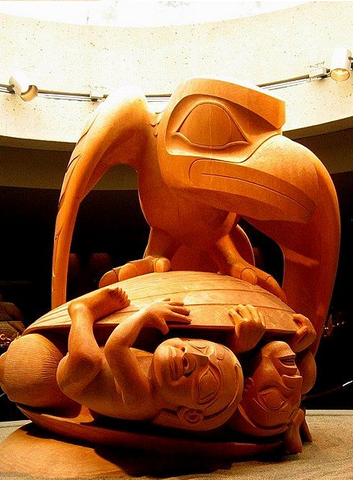
Sculpture by Bill Reid of Raven releasing the first men from a clam in the Haida creation story
Native name: Xhuuya, Wiigit, Saghani Ggayy, Dotson’sa among others
Equivalent: Coyote (Western NA Tribes), Rabbit (Southeast NA Tribes) among others
Deity of: Creation, Mischief
Race: Transformers
Spouse: N/A
Father of: N/A
In mythology:
Raven is a cultural hero of many societies in the Pacific Northwest, and goes by countless names and titles. Stories of his activities can vary significantly, though there are common themes of him as either creator or trickster – or both – with magical talents and the ability to shapeshift. He is often considered a complex reflection of one’s self and, despite being benevolent in general, his curiosities and selfishness regularly get the better of him. While some clans believe it was Raven who brought the Earth into being, others credit him with releasing light, fresh water, fire and even humans into the world. An interesting note, however, is that the legends tend to show his creativity through stealing or consequences rather than intent, and more than one involves the accidental death of another deity. As such, the Raven myths usually teach one how to live a good life by revealing the cost of bad actions. Xhuuya is his personal name in Haida mythology, while Yaahl is the literal word for raven.
In Axtelera Ray:
Xhuuya is considered to be one of the first and greatest of the Yaahl Tribe, remembered as the “Raven Father” and “Nankil’slas” (He Whose Voice must be Obeyed). His tales of heroism and wisdom are often intermingled with selfish cunning and troublemaking, and he was both loved and loathed by the ruling Great Spirit. Though his kin are plentiful in Western Octavia, his descendants reside in several places around the world, perhaps most notably the mysterious Kilsiid who offers royal counsel in Yggdrasil.
Learn more cool history and mythology trivia at our encyclopedia.
The post The Trickster Transformer of the Northwest Pacific appeared first on Axtelera-Ray.
March 18, 2015
Why are birthstones important?
Birthstones (or “Birthday Stones”) have existed as part of various cultures around the world for thousands of years, whether for astrological, medicinal, religious or purely aesthetic purposes. They are the precious or semi-precious gems associated with an individual’s month of birth – sometimes even their day of birth – and often worn on pendants or rings. Different lists exist to determine which stone should symbolize a specific time period; examples of this are the Ayurvedic list of India for use in healing, the Zodiac list created long before the Gregorian calendar was introduced, or the American National Association of Jewelers list that was decided in 1912 and continues to be followed. Some of the best known minerals include sapphire, ruby, garnet, diamond, emerald and amethyst.
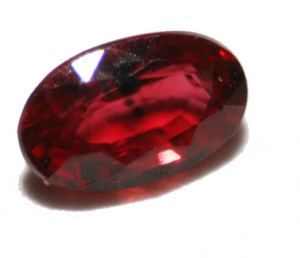
A polished ruby birthstone. Rubies are actually just red sapphires.
Gemstones had many uses in ancient times: the Egyptians considered some jewels to be the eyes of gods, while they had sacrificial roles for the Aztecs and mystic abilities for the Tibetans. The Babylonians believed that the stones possessed magical powers, and could endow their bearers with good fortune and health. Their astrologists created the Zodiac as a way of monitoring the movement of the stars and, since individuals’ personalities were affiliated with the celestial period in which they were born, the “attributes” of birthstones were assigned to best help and compliment these human characteristics. Many societies in antiquity such as those of Asia and South America also believed that the gems could cure wounds and illness. This ranged from placing the stone on a person’s skin to grinding it up into a paste for consumption. Ayurveda healing in India – thought to be around 3,500 years old – still incorporates birthstones in their methods.
It is alleged that the modern understanding of birthstones in Western culture derives from the Book of Exodus in the Hebrew Bible where, after escaping Egypt, Moses’ elder brother Aaron was named High Priest and wore a breastplate with twelve gems to represent the tribes of Israel. These later evolved with Christian beliefs to reflect the Foundation Stones of New Jerusalem and their connection to the twelve Apostles of Jesus Christ. It became common practice between the 17th and 18th centuries among European Christians to wear a different jewel each month to maximize their effect, though the religious significance behind this was eventually lost, and replaced by the Eastern tradition of wearing a single stone associated with the individual’s month of birth. As a result of changing customs and tastes, contemporary birthstone lists have little to do with their origins, but remain hugely popular and important for many people around the planet.
Learn more cool history and mythology trivia at our encyclopedia.
The post Why are birthstones important? appeared first on Axtelera-Ray.
March 11, 2015
Ragnarok: Doom of the Norse Gods
Most cultures or religions over the ages have foretold the end of the world in one form or another. Some believed that there would be a definitive termination of everything (linear cosmology), while others saw the world as simply part of a celestial cycle of life (cyclic cosmology), where death and rebirth was the natural order. Terms such as “End of Days”, “Apocalypse” and “Armageddon” are used to describe this, but the equivalent in Old Norse is Ragnarök or Ragnarøkkr which translate as “Doom of the Gods” and “Twilight of the Gods” respectively.
The Ragnarök prophecy appears in the Eddas, and details the bloody and brutal manner in which this life-cycle will draw to a close. Both on Miðgarðr (Earth) and Asgarðr (Asgard – home of the Gods), traditions and kinship will have been discarded, oaths will count for little, and whoring and murder will be rife. Oðinn (Odin) will prepare for Ragnarök by training the Einherjar – his army of warriors who died in glorious battle – but knows they cannot escape their fate. Three things are said to herald the Doom of the Gods: Oðinn’s son Baldr (Baldur) will be killed and sent to the underworld, Hel; Miðgarðr will experience frequent winters until the time of Fimbulvetr (the Great Winter) where the world will be seized by cold and darkness; three roosters will crow to signal the beginning of the conflict, one in Asgarðr, one in Hel, and one in Jötunheimr (Jotunheim – home of the Rock Giants).
Breaking free of the chains in which he was bound for his role in Baldr’s death, Loki will raise an army of the dead in Hel and march on Asgarðr, to be later joined by the Hrímthursar (Frost Giants). The giant wolf Fenrir will also escape his imprisonment to seek his revenge on the Gods, while Jörmungandr – the enormous serpent that surrounds Miðgarðr – will slither from the cosmic sea. In the south, the Eldjötnar (Fire Giants) will ride forth from Múspellsheimr (Muspelheim – home of the Fire Giants), led by Surtr (Surt) and burn the land as they go. It will cause all of Yggdrasil (the world-tree) to shudder violently, and when the alarm is sounded in Asgarðr, Oðinn will command his people to ready themselves for battle.

Thor takes on Jormungand but neither survives the battle.
The Gods and the Einherjar will meet the invaders on the field of Vígríðr (Vigrid) and fight valiantly, but their opponents will be equal to them. Loki and Heimdallr (Heimdall) will slay one another, as will Þor (Thor) and Jörmungandr, while Fenrir will eat Oðinn whole, only to be avenged by another of the latter’s sons, Viðarr (Vidar). Freyr (Frey) will engage Surtr but fail, and the Eldjötun will set the Nine Worlds ablaze, causing the sun to turn black and Miðgarðr to sink into the cosmic sea.
Sometime after Ragnarök has ended, Miðgarðr will emerge once more, fertile and plentiful, and the sun will return to the sky. It will be repopulated by the two human survivors, Líf (Lif) and Lífþrasir (Lifthrasir), who hid in Yggdrasil and whose tale reflects the Norse creation myth. Baldr will be resurrected and meet with the few Gods who have remained in Asgarðr to establish a new and happy existence for themselves at Iðavöllr (Idavoll). Thus the cycle of life will begin again.
Learn more interesting historical and mythological trivia in our encyclopedia.
The post Ragnarok: Doom of the Norse Gods appeared first on Axtelera-Ray.
March 7, 2015
There’s a new Princess in town…
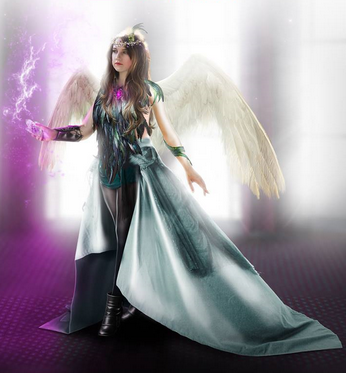 The daughter of King Astrone and Queen Zabrina, Sabryana is adored throughout the Realm of Asgard and indeed the Kingdom of Yggdrasil. The jewel of her father’s eye, she is affectionately known as the ‘Little Sorceress’ for her raw magical potential and education on advanced spellcasting. She has a good heart, and believes that kindness and courage can be a shining beacon in even the blackest night. However, having witnessed terrible atrocities during the Battle of Stellarheim and her brother’s seizure of the Throne of Valhalla, she must abandon her privileged life to lead a rebellion against this usurper.
The daughter of King Astrone and Queen Zabrina, Sabryana is adored throughout the Realm of Asgard and indeed the Kingdom of Yggdrasil. The jewel of her father’s eye, she is affectionately known as the ‘Little Sorceress’ for her raw magical potential and education on advanced spellcasting. She has a good heart, and believes that kindness and courage can be a shining beacon in even the blackest night. However, having witnessed terrible atrocities during the Battle of Stellarheim and her brother’s seizure of the Throne of Valhalla, she must abandon her privileged life to lead a rebellion against this usurper.
Behind her youthful complexion and inexperienced eyes, Sabryana is cunning and clever, and will do whatever it takes to avenge her family. She is prepared to stare danger in the face and make the impossible decisions, but only when the moment is right will she unleash her secret weapon: the Earthborn. As the princess’ new friends ready themselves for civil war, she conceals from them her own desperate struggles to control her newly-inherited precognition gifts, as well as the dark details of her plot to restore balance to the kingdom…
Associated Trivia:
– Yggdrasil is the name of the World Tree in Norse mythology which connects the nine worlds. Our own realm, the world of humans, was called Midgard. The Realm of Asgard was where the ruling Gods were believed to live, the most famous of whom include Odin and Thor.
– Precognition is the ability to see into the future or gather information about events yet to come.
Learn about more Axtelera Ray characters
The post There’s a new Princess in town… appeared first on Axtelera-Ray.

